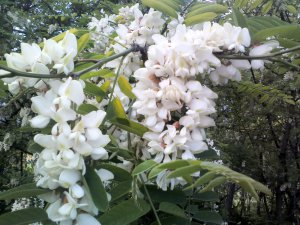An Introduction to Black Locust:
Robinia pseudoacacia or Black Locust as it is commonly known is a native plant or weed that grows on the sides of streets. A lot of people may know it for its beauty when it flowers (which we will touch upon later). It has also built up quite a reputation for being invasive as well. In short we can consider it quite an interesting tree as a whole.

Places where you can spot Black Locust:
You may find this native plant in places such as woodland areas where there is plenty of sunlight and relatively dry soil which the Black Locust tree prefers.
Physical Appearance:
The Black Locust tree may grow in between 12 to 30 meters and have a girth of up to 1 meter or more though there have been records of trees that were older reaching upwards of 50 meters and 1.5 meters in diameter. The leaves are dark green with hints of blue in color which make the plant quite appealing.
To add more to the plant’s appeal, it has large fragrant flowers that are orange in color.
Under the ground it has suckers or as shoots as some call them. They make the plant strongly anchored with the ground.
Distribution and importance of this native plant:
You may find Black locust in the eastern parts of the United States with it also spreading to other parts as well. You may also find it in Canada on various mountain ranges and biomes.
Due to human intervention you can now see Black Locust in many other places around the globe. Such as Pakistan, Canada, China, Europe and more.
It has gained an invasive status due to how easily it spreads to a new region. Some parts of the United States have even declared it as invasive and may have started taking measures against its growth.
Black locust may have also caused some ecological damage due to its affinity to grow more and more which may compete with the local plant life unduly.
The role of Black Locust in Cooking:
You may find that some parts of black locust that are toxic and are not fit for consumption such as the bark and leaves. You can also eat its pods and seeds cooked or raw. The flowers of Black locust can be cooked as well.
If you intend to forage for Black Locust flowers do take care when picking out the finest flowers as opposed to those that are withering. If you want to store them, do so in a suitable container and do not put them in the refrigerator.
You can use the flowers of the Black Locust in salads and a variety of dishes. You can also find a type of honey derived from Black Locust that is used in a lot of dishes; ranging from teas to many deserts. Black Locust Honey tea would definitely a winner when it comes to soothing your nerves after a hectic day of work or if you would like to enjoy some peace and serenity alone.
The Medicinal Uses of Black locust:
Black locust may be used in the case of burn wounds where you can apply it to relieve the pain. Ingesting it for medicinal use is not usually recommended though some suggest it may help in digestion.
People with asthma or any other ailment of the lungs may benefit from the use of Black Locust. Consult medical professional beforehand. If you have been experiencing headaches or have been feeling tense, it may help in calming you down. People facing insomnia may also be treated with Black Locust.
Health and Safety:
Keep in mind this plant does have a lot of toxic parts. Use carefully if you intend to use it for medical or culinary needs. Though heating it may render it a bit less toxic, you can never be too safe. Consult a doctor before you intend to consume it. Inshort be mindful while using this native plant for just about anything.
For information on Black Locust Honey go to:
https://www.honeybeesuite.com/black-locust-honey/
To read about another Handy Fragrant plant go to:
https://eattheplanet.org/native-american-plant-herb/
Many of our readers find that subscribing to Eat The Planet is the best way to make sure they don't miss any of our valuable information about wild edibles.
See our privacy policy for more information about ads on this site







One Response
what are the best cbd waxes?